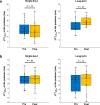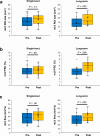Long-term physical exercise facilitates putative glymphatic and meningeal lymphatic vessel flow in humans
- PMID: 40204790
- PMCID: PMC11982307
- DOI: 10.1038/s41467-025-58726-1
Long-term physical exercise facilitates putative glymphatic and meningeal lymphatic vessel flow in humans
Abstract
Regular voluntary exercise has been shown to increase waste transport through the glymphatic system in mice. Here, we investigate the impact of physical exercise on both upstream and downstream brain waste clearance in healthy volunteers via noninvasive MR imaging. Putative glymphatic influx, evaluated using intravenous contrast-enhanced dynamic T1 mapping, increases significantly at the putamen after 12 weeks of long-term exercise using a cycle ergometer. The putative meningeal lymphatic vessel size and flow, measured by intravenous contrast-enhanced black-blood imaging and IR-ALADDIN technique, increase significantly after long-term exercise. Plasma proteomics reveals significant changes in inflammation-related and immune-related proteins (down-regulated: S100A8, S100A9, PSMA3, and DEFA1A3; up-regulated: J chain) after long-term exercise, which correlate with putative glymphatic influx or mLV flow. Our results suggest that increased glymphatic and mLV flow may be the potential mechanism underlying the neuroprotective effects of exercise on cognition, highlighting the importance of long-term, regular exercise.
© 2025. The Author(s).
Conflict of interest statement
Competing interests: The authors declare no competing interests.
Figures







References
MeSH terms
Grants and funding
- RS-2023-00224382/Ministry of Science, ICT and Future Planning (MSIP)
- RS-2023-00207783/Ministry of Science, ICT and Future Planning (MSIP)
- NRF-2022R1I1A4053049/Ministry of Science, ICT and Future Planning (MSIP)
- 2022R1A5A8019303/Ministry of Science, ICT and Future Planning (MSIP)
- NRF-2023R1A2C3003250/Ministry of Science, ICT and Future Planning (MSIP)
LinkOut - more resources
Full Text Sources
Medical
Miscellaneous

